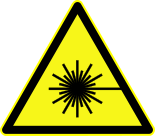Laser

A laser is a device that emits
A laser differs from other sources of light in that it emits light that is
Lasers are used in
Terminology
The first device using amplification by stimulated emission operated at microwave frequencies, and was called a maser, for "microwave amplification by stimulated emission of radiation".[8] When similar optical devices were developed they were first known as optical masers, until "microwave" was replaced by "light" in the acronym, to become laser.[9]
Today, all such devices operating at frequencies higher than microwaves (approximately above 300 GHz) are called lasers (e.g. infrared lasers, ultraviolet lasers, X-ray lasers, gamma-ray lasers), whereas devices operating at microwave or lower radio frequencies are called masers.[10][11]
The back-formed verb "to lase" is frequently used in the field, meaning "to give off coherent light," especially about the gain medium of a laser;[12] when a laser is operating it is said to be "lasing".[13] The terms laser and maser are also used for naturally occurring coherent emissions, as in astrophysical maser and atom laser.[14][15]
A laser that produces light by itself is technically an optical oscillator rather than an optical amplifier as suggested by the acronym.[16] It has been humorously noted that the acronym LOSER, for "light oscillation by stimulated emission of radiation", would have been more correct.[15] With the widespread use of the original acronym as a common noun, optical amplifiers have come to be referred to as laser amplifiers.[17]
Fundamentals
This section needs additional citations for verification. (October 2023) |

Modern physics describes light and other forms of
Thermal radiation is a random process, and thus the photons emitted have a range of different wavelengths, travel in different directions, and are released at different times. The energy within the object is not random, however: it is stored by atoms and molecules in "excited states", which release photons with distinct wavelengths. This gives rise to the science of spectroscopy, which allows materials to be determined through the specific wavelengths that they emit.
The underlying physical process creating photons in a laser is the same as in thermal radiation, but the actual emission is not the result of random thermal processes. Instead, the release of a photon is triggered by the nearby passage of another photon. This is called stimulated emission. For this process to work, the passing photon must be similar in energy, and thus wavelength, to the one that could be released by the atom or molecule, and the atom or molecule must be in the suitable excited state.
The photon that is emitted by stimulated emission is identical to the photon that triggered its emission, and both photons can go on to trigger stimulated emission in other atoms, creating the possibility of a chain reaction. For this to happen, many of the atoms or molecules must be in the proper excited state so that the photons can trigger them. In most materials, atoms or molecules drop out of excited states fairly rapidly, making it difficult or impossible to produce a chain reaction. The materials chosen for lasers are the ones that have metastable states, which stay excited for a relatively long time. In laser physics, such a material is called an active laser medium. Combined with an energy source that continues to "pump" energy into the material, this makes it possible to have enough atoms or molecules in an excited state for a chain reaction to develop.
Lasers are distinguished from other light sources by their coherence. Spatial (or transverse) coherence is typically expressed through the output being a narrow beam, which is diffraction-limited. Laser beams can be focused to very tiny spots, achieving a very high irradiance, or they can have a very low divergence to concentrate their power at a great distance. Temporal (or longitudinal) coherence implies a polarized wave at a single frequency, whose phase is correlated over a relatively great distance (the coherence length) along the beam.[18][page needed] A beam produced by a thermal or other incoherent light source has an instantaneous amplitude and phase that vary randomly with respect to time and position, thus having a short coherence length.
Lasers are characterized according to their
Design
This section needs additional citations for verification. (October 2023) |
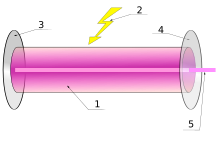
- Gain medium
- Laser pumping energy
- High reflector
- Output coupler
- Laser beam
A laser consists of a gain medium, a mechanism to energize it, and something to provide optical feedback.[19] The gain medium is a material with properties that allow it to amplify light by way of stimulated emission. Light of a specific wavelength that passes through the gain medium is amplified (power increases). Feedback enables stimulated emission to amplify predominantly the optical frequency at the peak of the gain-frequency curve. As stimulated emission grows, eventually one frequency dominates over all others, meaning that a coherent beam has been formed.[20][page needed] The process of stimulated emission is analogous to that of an audio oscillator with positive feedback which can occur, for example, when the speaker in a public-address system is placed in proximity to the microphone. The screech one hears is audio oscillation at the peak of the gain-frequency curve for the amplifier.[21][page needed]
For the gain medium to amplify light, it needs to be supplied with energy in a process called
The most common type of laser uses feedback from an optical cavity—a pair of mirrors on either end of the gain medium. Light bounces back and forth between the mirrors, passing through the gain medium and being amplified each time. Typically one of the two mirrors, the output coupler, is partially transparent. Some of the light escapes through this mirror. Depending on the design of the cavity (whether the mirrors are flat or curved), the light coming out of the laser may spread out or form a narrow beam. In analogy to electronic oscillators, this device is sometimes called a laser oscillator.
Most practical lasers contain additional elements that affect the properties of the emitted light, such as the polarization, wavelength, and shape of the beam.[citation needed]
Laser physics
This section needs additional citations for verification. (May 2017) |
Electrons and how they interact with electromagnetic fields are important in our understanding of chemistry and physics.
Stimulated emission
In the classical view, the energy of an electron orbiting an atomic nucleus is larger for orbits further from the nucleus of an atom. However, quantum mechanical effects force electrons to take on discrete positions in orbitals. Thus, electrons are found in specific energy levels of an atom, two of which are shown below:

An electron in an atom can absorb energy from light (photons) or heat (phonons) only if there is a transition between energy levels that match the energy carried by the photon or phonon. For light, this means that any given transition will only absorb one particular wavelength of light. Photons with the correct wavelength can cause an electron to jump from the lower to the higher energy level. The photon is consumed in this process.
When an electron is
A photon with the correct wavelength to be absorbed by a transition can also cause an electron to drop from the higher to the lower level, emitting a new photon. The emitted photon exactly matches the original photon in wavelength, phase, and direction. This process is called stimulated emission.
Gain medium and cavity

The gain medium is put into an excited state by an external source of energy. In most lasers, this medium consists of a population of atoms that have been excited into such a state using an outside light source, or an electrical field that supplies energy for atoms to absorb and be transformed into their excited states.
The gain medium of a laser is normally a material of controlled purity, size, concentration, and shape, which amplifies the beam by the process of stimulated emission described above. This material can be of any state: gas, liquid, solid, or plasma. The gain medium absorbs pump energy, which raises some electrons into higher energy ("excited") quantum states. Particles can interact with light by either absorbing or emitting photons. Emission can be spontaneous or stimulated. In the latter case, the photon is emitted in the same direction as the light that is passing by. When the number of particles in one excited state exceeds the number of particles in some lower-energy state, population inversion is achieved. In this state, the rate of stimulated emission is larger than the rate of absorption of light in the medium, and therefore the light is amplified. A system with this property is called an optical amplifier. When an optical amplifier is placed inside a resonant optical cavity, one obtains a laser.[22]
For lasing media with extremely high gain, so-called
The optical resonator is sometimes referred to as an "optical cavity", but this is a misnomer: lasers use open resonators as opposed to the literal cavity that would be employed at microwave frequencies in a maser. The resonator typically consists of two mirrors between which a coherent beam of light travels in both directions, reflecting on itself so that an average photon will pass through the gain medium repeatedly before it is emitted from the output aperture or lost to diffraction or absorption. If the gain (amplification) in the medium is larger than the resonator losses, then the power of the recirculating light can rise
The light emitted
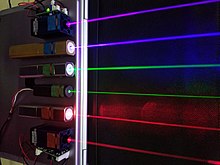
In most lasers, lasing begins with spontaneous emission into the lasing mode. This initial light is then amplified by stimulated emission in the gain medium. Stimulated emission produces light that matches the input signal in direction, wavelength, and polarization, whereas the phase of the emitted light is 90 degrees in lead of the stimulating light.[24] This, combined with the filtering effect of the optical resonator gives laser light its characteristic coherence, and may give it uniform polarization and monochromaticity, depending on the resonator's design. The fundamental laser linewidth[25] of light emitted from the lasing resonator can be orders of magnitude narrower than the linewidth of light emitted from the passive resonator. Some lasers use a separate injection seeder to start the process off with a beam that is already highly coherent. This can produce beams with a narrower spectrum than would otherwise be possible.
In 1963,
Many lasers produce a beam that can be approximated as a Gaussian beam; such beams have the minimum divergence possible for a given beam diameter. Some lasers, particularly high-power ones, produce multimode beams, with the transverse modes often approximated using Hermite–Gaussian or Laguerre-Gaussian functions. Some high-power lasers use a flat-topped profile known as a "tophat beam". Unstable laser resonators (not used in most lasers) produce fractal-shaped beams.[27] Specialized optical systems can produce more complex beam geometries, such as Bessel beams and optical vortexes.
Near the "waist" (or
A laser beam profiler is used to measure the intensity profile, width, and divergence of laser beams.
Quantum vs. classical emission processes
The mechanism of producing radiation in a laser relies on
Modes of operation
This section needs additional citations for verification. (February 2023) |
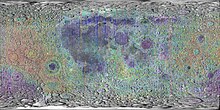
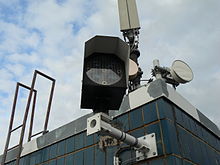

A laser can be classified as operating in either continuous or pulsed mode, depending on whether the power output is essentially continuous over time or whether its output takes the form of pulses of light on one or another time scale. Of course, even a laser whose output is normally continuous can be intentionally turned on and off at some rate to create pulses of light. When the modulation rate is on time scales much slower than the cavity lifetime and the period over which energy can be stored in the lasing medium or pumping mechanism, then it is still classified as a "modulated" or "pulsed" continuous wave laser. Most laser diodes used in communication systems fall into that category.
Continuous-wave operation
Some applications of lasers depend on a beam whose output power is constant over time. Such a laser is known as
For continuous-wave operation, it is required for the population inversion of the gain medium to be continually replenished by a steady pump source. In some lasing media, this is impossible. In some other lasers, it would require pumping the laser at a very high continuous power level, which would be impractical, or destroying the laser by producing excessive heat. Such lasers cannot be run in CW mode.
Pulsed operation
The pulsed operation of lasers refers to any laser not classified as a continuous wave so that the optical power appears in pulses of some duration at some repetition rate. This encompasses a wide range of technologies addressing many different motivations. Some lasers are pulsed simply because they cannot be run in continuous mode.
In other cases, the application requires the production of pulses having as large an energy as possible. Since the pulse energy is equal to the average power divided by the repetition rate, this goal can sometimes be satisfied by lowering the rate of pulses so that more energy can be built up between pulses. In laser ablation, for example, a small volume of material at the surface of a workpiece can be evaporated if it is heated in a very short time, while supplying the energy gradually would allow for the heat to be absorbed into the bulk of the piece, never attaining a sufficiently high temperature at a particular point.
Other applications rely on the peak pulse power (rather than the energy in the pulse), especially to obtain
The optical bandwidth of a pulse cannot be narrower than the reciprocal of the pulse width. In the case of extremely short pulses, that implies lasing over a considerable bandwidth, quite contrary to the very narrow bandwidths typical of CW lasers. The lasing medium in some dye lasers and vibronic solid-state lasers produces optical gain over a wide bandwidth, making a laser possible that can thus generate pulses of light as short as a few
Q-switching
In a Q-switched laser, the population inversion is allowed to build up by introducing loss inside the resonator which exceeds the gain of the medium; this can also be described as a reduction of the quality factor or 'Q' of the cavity. Then, after the pump energy stored in the laser medium has approached the maximum possible level, the introduced loss mechanism (often an electro- or acousto-optical element) is rapidly removed (or that occurs by itself in a passive device), allowing lasing to begin which rapidly obtains the stored energy in the gain medium. This results in a short pulse incorporating that energy, and thus a high peak power.
Mode locking
A mode-locked laser is capable of emitting extremely short pulses on the order of tens of
Such mode-locked lasers are a most versatile tool for researching processes occurring on extremely short time scales (known as femtosecond physics,
Pulsed pumping
Another method of achieving pulsed laser operation is to pump the laser material with a source that is itself pulsed, either through electronic charging in the case of flash lamps, or another laser that is already pulsed. Pulsed pumping was historically used with dye lasers where the inverted population lifetime of a dye molecule was so short that a high-energy, fast pump was needed. The way to overcome this problem was to charge up large
History
Foundations
In 1917,
Maser
In 1951, Joseph Weber submitted a paper on using stimulated emissions to make a microwave amplifier to the June 1952 Institute of Radio Engineers Vacuum Tube Research Conference at Ottawa, Ontario, Canada.[32] After this presentation, RCA asked Weber to give a seminar on this idea, and Charles H. Townes asked him for a copy of the paper.[33]
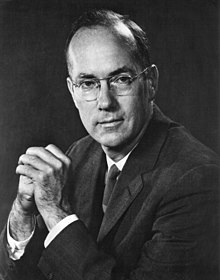
In 1953, Charles H. Townes and graduate students
Townes reports that several eminent physicists—among them
Laser
In April 1957, Japanese engineer
| External audio | |
|---|---|
That same year, Charles H. Townes and Arthur Leonard Schawlow, then at
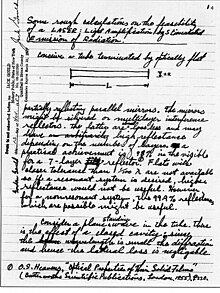
Simultaneously,
At a conference in 1959, Gordon Gould first published the acronym "LASER" in the paper The LASER, Light Amplification by Stimulated Emission of Radiation.[38][15] Gould's intention was that different "-ASER" acronyms should be used for different parts of the spectrum: "XASER" for x-rays, "UVASER" for ultraviolet, etc. "LASER" ended up becoming the generic term for non-microwave devices, although "RASER" was briefly popular for denoting radio-frequency-emitting devices.
Gould's notes included possible applications for a laser, such as
On May 16, 1960, Theodore H. Maiman operated the first functioning laser
Recent innovations
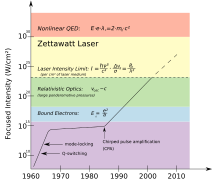
Since the early period of laser history, laser research has produced a variety of improved and specialized laser types, optimized for different performance goals, including:
- new wavelength bands
- maximum average output power
- maximum peak pulse energy
- maximum peak pulse power
- minimum output pulse duration
- minimum linewidth
- maximum power efficiency
- minimum cost
and this research continues to this day.
In 2015, researchers made a white laser, whose light is modulated by a synthetic nanosheet made out of zinc, cadmium, sulfur, and selenium that can emit red, green, and blue light in varying proportions, with each wavelength spanning 191 nm.[43][44][45]
In 2017, researchers at the Delft University of Technology demonstrated an AC Josephson junction microwave laser.[46] Since the laser operates in the superconducting regime, it is more stable than other semiconductor-based lasers. The device has the potential for applications in quantum computing.[47] In 2017, researchers at the Technical University of Munich demonstrated the smallest mode locking laser capable of emitting pairs of phase-locked picosecond laser pulses with a repetition frequency up to 200 GHz.[48]
In 2017, researchers from the Physikalisch-Technische Bundesanstalt (PTB), together with US researchers from JILA, a joint institute of the National Institute of Standards and Technology (NIST) and the University of Colorado Boulder, established a new world record by developing an erbium-doped fiber laser with a linewidth of only 10 millihertz.[49][50]
Types and operating principles
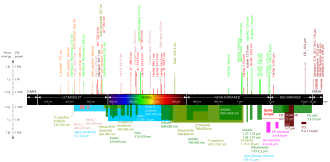
Gas lasers
Following the invention of the HeNe gas laser, many other gas discharges have been found to amplify light coherently. Gas lasers using many different gases have been built and used for many purposes. The
.Lasing without maintaining the medium excited into a population inversion was demonstrated in 1992 in sodium gas and again in 1995 in rubidium gas by various international teams.[54][55][page needed] This was accomplished by using an external maser to induce "optical transparency" in the medium by introducing and destructively interfering the ground electron transitions between two paths so that the likelihood for the ground electrons to absorb any energy has been canceled.
Chemical lasers
Excimer lasers
Solid-state lasers
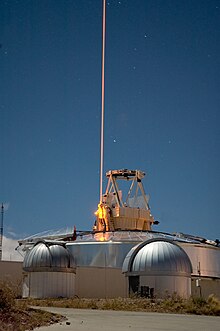
Solid-state lasers use a crystalline or glass rod that is "doped" with ions that provide the required energy states. For example, the first working laser was a ruby laser, made from ruby (chromium-doped corundum). The population inversion is maintained in the dopant. These materials are pumped optically using a shorter wavelength than the lasing wavelength, often from a flash tube or another laser. The usage of the term "solid-state" in laser physics is narrower than in typical use. Semiconductor lasers (laser diodes) are typically not referred to as solid-state lasers.
Ytterbium, holmium, thulium, and erbium are other common "dopants" in solid-state lasers.[57][page needed] Ytterbium is used in crystals such as Yb:YAG, Yb:KGW, Yb:KYW, Yb:SYS, Yb:BOYS, Yb:CaF2, typically operating around 1020–1050 nm. They are potentially very efficient and high-powered due to a small quantum defect. Extremely high powers in ultrashort pulses can be achieved with Yb:YAG. Holmium-doped YAG crystals emit at 2097 nm and form an efficient laser operating at infrared wavelengths strongly absorbed by water-bearing tissues. The Ho-YAG is usually operated in a pulsed mode and passed through optical fiber surgical devices to resurface joints, remove rot from teeth, vaporize cancers, and pulverize kidney and gall stones.
Titanium-doped sapphire (Ti:sapphire) produces a highly tunable infrared laser, commonly used for spectroscopy. It is also notable for use as a mode-locked laser producing ultrashort pulses of extremely high peak power.
Thermal limitations in solid-state lasers arise from unconverted pump power that heats the medium. This heat, when coupled with a high thermo-optic coefficient (dn/dT) can cause thermal lensing and reduce the quantum efficiency. Diode-pumped thin disk lasers overcome these issues by having a gain medium that is much thinner than the diameter of the pump beam. This allows for a more uniform temperature in the material. Thin disk lasers have been shown to produce beams of up to one kilowatt.[58]
Fiber lasers
Solid-state lasers or laser amplifiers where the light is guided due to the total internal reflection in a single mode optical fiber are instead called fiber lasers. Guiding of light allows extremely long gain regions providing good cooling conditions; fibers have a high surface area to volume ratio which allows efficient cooling. In addition, the fiber's waveguiding properties tend to reduce the thermal distortion of the beam. Erbium and ytterbium ions are common active species in such lasers.
Quite often, the fiber laser is designed as a double-clad fiber. This type of fiber consists of a fiber core, an inner cladding, and an outer cladding. The index of the three concentric layers is chosen so that the fiber core acts as a single-mode fiber for the laser emission while the outer cladding acts as a highly multimode core for the pump laser. This lets the pump propagate a large amount of power into and through the active inner core region, while still having a high numerical aperture (NA) to have easy launching conditions.
Pump light can be used more efficiently by creating a fiber disk laser, or a stack of such lasers.
Fiber lasers, like other optical media, can suffer from the effects of
Photonic crystal lasers
Photonic crystal lasers are lasers based on nano-structures that provide the mode confinement and the density of optical states (DOS) structure required for the feedback to take place.[clarification needed] They are typical micrometer-sized[dubious ] and tunable on the bands of the photonic crystals.[60][clarification needed]
Semiconductor lasers
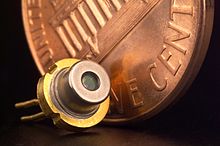
Semiconductor lasers are diodes that are electrically pumped. Recombination of electrons and holes created by the applied current introduces optical gain. Reflection from the ends of the crystal forms an optical resonator, although the resonator can be external to the semiconductor in some designs.
Commercial
In 2012,
Vertical cavity surface-emitting lasers (
The development of a
Dye lasers

Free-electron lasers

Free-electron lasers (FEL) generate coherent, high-power radiation that is widely tunable, currently ranging in wavelength from microwaves through terahertz radiation and infrared to the visible spectrum, to soft X-rays. They have the widest frequency range of any laser type. While FEL beams share the same optical traits as other lasers, such as coherent radiation, FEL operation is quite different. Unlike gas, liquid, or solid-state lasers, which rely on bound atomic or molecular states, FELs use a relativistic electron beam as the lasing medium, hence the term free-electron.
Exotic media
The pursuit of a high-quantum-energy laser using transitions between isomeric states of an atomic nucleus has been the subject of wide-ranging academic research since the early 1970s. Much of this is summarized in three review articles.[68][69][70] This research has been international in scope but mainly based in the former Soviet Union and the United States. While many scientists remain optimistic that a breakthrough is near, an operational gamma-ray laser is yet to be realized.[71]
Some of the early studies were directed toward short pulses of neutrons exciting the upper isomer state in a solid so the gamma-ray transition could benefit from the line-narrowing of Mössbauer effect.[72][page needed][73] In conjunction, several advantages were expected from two-stage pumping of a three-level system.[74] It was conjectured that the nucleus of an atom, embedded in the near field of a laser-driven coherently-oscillating electron cloud would experience a larger dipole field than that of the driving laser.[75][76] Furthermore, the nonlinearity of the oscillating cloud would produce both spatial and temporal harmonics, so nuclear transitions of higher multipolarity could also be driven at multiples of the laser frequency.[77][78][79][80][81][82][83]
In September 2007, the BBC News reported that there was speculation about the possibility of using positronium annihilation to drive a very powerful gamma ray laser.[84] David Cassidy of the University of California, Riverside proposed that a single such laser could be used to ignite a nuclear fusion reaction, replacing the banks of hundreds of lasers currently employed in inertial confinement fusion experiments.[84]
Space-based X-ray lasers pumped by a nuclear explosion have also been proposed as antimissile weapons.[85][86] Such devices would be one-shot weapons.
Living cells have been used to produce laser light.[87][88] The cells were genetically engineered to produce green fluorescent protein, which served as the laser's gain medium. The cells were then placed between two 20-micrometer-wide mirrors, which acted as the laser cavity. When the cell was illuminated with blue light, it emitted intensely directed green laser light.
Natural lasers
Like astrophysical masers, irradiated planetary or stellar gases may amplify light producing a natural laser.[89] Mars,[90] Venus and MWC 349 exhibit this phenomenon.
Uses
When lasers were invented in 1960, they were called "a solution looking for a problem".
The first widely noticeable use of lasers was the supermarket
Some other uses are:
- Communications: besides fiber-optic communication, lasers are used for free-space optical communication, including laser communication in space
- Medicine: see below
- Industry: laser cleaning.
- Military: marking targets, guiding
- LIDAR traffic enforcement. Lasers are used for latent fingerprint detection in the forensic identification field[92][93]
- Research: fluorescence microscopy, metrology, laser cooling
- Commercial products: holograms, bubblegrams
- Entertainment: optical discs, laser lighting displays, laser turntables.
- Informational markings: Laser lighting display technology can be used to project informational markings onto surfaces such as playing fields, roads, runways, or warehouse floors.[94][95][96]
In 2004, excluding diode lasers, approximately 131,000 lasers were sold with a value of US$2.19 billion.[97] In the same year, approximately 733 million diode lasers, valued at US$3.20 billion, were sold.[98]
In medicine
Lasers have many uses in medicine, including
Lasers are used to treat
As weapons
This article should include a summary of Laser weapon. (December 2019) |
A laser weapon is a laser that is used as a directed-energy weapon.
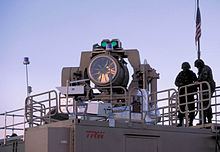
Hobbies
In recent years, some hobbyists have taken an interest in lasers. Lasers used by hobbyists are generally of class IIIa or IIIb
Hobbyists have also used surplus lasers taken from retired military applications and modified them for holography. Pulsed ruby and YAG lasers work well for this application.
Examples by power
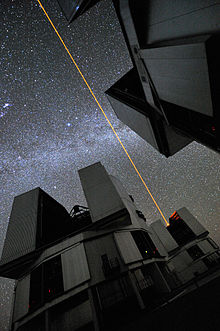
Different applications need lasers with different output powers. Lasers that produce a continuous beam or a series of short pulses can be compared on the basis of their average power. Lasers that produce pulses can also be characterized based on the peak power of each pulse. The peak power of a pulsed laser is many
| Power | Use |
|---|---|
| 1–5 mW | Laser pointers |
| 5 mW | CD-ROM drive |
| 5–10 mW | DVD-ROM drive
|
| 100 mW | High-speed CD-RW burner |
| 250 mW | Consumer 16× DVD-R burner
|
| 400 mW | DVD 24× dual-layer recording[103] |
| 1 W | Green laser in Holographic Versatile Disc prototype development |
| 1–20 W | Output of the majority of commercially available solid-state lasers used for micro machining |
| 30–100 W | Typical sealed CO2 surgical lasers[104] |
| 100–3000 W | Typical sealed CO2 lasers used in industrial laser cutting |
Examples of pulsed systems with high peak power:
- 700 TW (700×1012 W)—National Ignition Facility, a 192-beam, 1.8-megajoule laser system adjoining a 10-meter-diameter target chamber[105]
- 10
Safety
Even the first laser was recognized as being potentially dangerous.
Lasers are usually labeled with a safety class number, which identifies how dangerous the laser is:
- Class 1 is inherently safe, usually because the light is contained in an enclosure, for example in CD players
- Class 2 is safe during normal use; the blink reflexof the eye will prevent damage. Usually up to 1 mW power, for example, laser pointers.
- Class 3R (formerly IIIa) lasers are usually up to 5 mW and involve a small risk of eye damage within the time of the blink reflex. Staring into such a beam for several seconds is likely to cause damage to a spot on the retina.
- Class 3B lasers (5–499 mW) can cause immediate eye damage upon exposure.
- Class 4 lasers (≥ 500 mW) can burn skin, and in some cases, even scattered light from these lasers can cause eye and/or skin damage. Many industrial and scientific lasers are in this class.
The indicated powers are for visible-light, continuous-wave lasers. For pulsed lasers and invisible wavelengths, other power limits apply. People working with class 3B and class 4 lasers can protect their eyes with safety goggles which are designed to absorb light of a particular wavelength.
Infrared lasers with wavelengths longer than about 1.4 micrometers are often referred to as "eye-safe", because the cornea tends to absorb light at these wavelengths, protecting the retina from damage. The label "eye-safe" can be misleading, however, as it applies only to relatively low-power continuous wave beams; a high-power or
Lasers can be a hazard to both civil and military aviation, due to the potential to temporarily distract or blind pilots. See Lasers and aviation safety for more on this topic.
Cameras based on charge-coupled devices may be more sensitive to laser damage than biological eyes.[109]
See also
References
- ISBN 978-0684835150.
- ISBN 978-0-8194-3922-2.
- ^ "December 1958: Invention of the Laser". aps.org. Archived from the original on December 10, 2021. Retrieved January 27, 2022.
- ^ "Semiconductor Sources: Laser plus phosphor emits white light without droop". November 7, 2013. Archived from the original on June 13, 2016. Retrieved February 4, 2019.
- ^ "Laser Lighting: White-light lasers challenge LEDs in directional lighting applications". February 22, 2017. Archived from the original on February 7, 2019. Retrieved February 4, 2019.
- ^ "How Laser-powered Headlights Work". November 7, 2011. Archived from the original on November 16, 2011. Retrieved February 4, 2019.
- ^ "Laser light for headlights: Latest trend in car lighting | OSRAM Automotive". Archived from the original on February 7, 2019. Retrieved February 4, 2019.
- ISBN 978-0-19-974376-6.
- ISBN 978-1-4200-3340-3.
- ISBN 978-0-470-25560-5.
- ISBN 978-3-642-23565-8.
- ^ "LASE". Collins Dictionary. Retrieved January 6, 2024.
- ^ "LASING". Collins Dictionary. Retrieved January 6, 2024.
- S2CID 115181195.
- ^ ISBN 978-0-309-08699-8.
- ISBN 978-3-319-31903-2.
- ISBN 978-1-119-31064-8.
- ^ Conceptual physics, Paul Hewitt, 2002
- ISBN 978-0-935702-11-8.
- ^ from the original on February 25, 2021. Retrieved February 23, 2021.
- ISBN 978-0-07-162935-5. Archived from the originalon August 17, 2021. Retrieved February 23, 2021.
- ISBN 978-0-935702-11-8.
- )
- from the original on February 8, 2023. Retrieved June 28, 2020.
- .
- (PDF) from the original on May 8, 2021. Retrieved February 23, 2021.
- S2CID 205046813.
- Bibcode:1917PhyZ...18..121E.
- ^ a b Steen, W.M. "Laser Materials Processing", 2nd Ed. 1998.
- ^ Batani, Dimitri (2004). "Il rischio da laser: cosa è e come affrontarlo; analisi di un problema non così lontano da noi" [The risk from laser: what it is and what it is like facing it; analysis of a problem which is thus not far away from us]. wwwold.unimib.it. Programma Corso di Formazione Obbligatorio (in Italian). University of Milano-Bicocca. p. 12. Archived from the original (Powerpoint) on June 14, 2007. Retrieved January 1, 2007.
- ^ The Nobel Prize in Physics 1966 Archived June 4, 2011, at the Wayback Machine Presentation Speech by Professor Ivar Waller. Retrieved January 1, 2007.
- ^ "American Institute of Physics Oral History Interview with Joseph Weber". May 4, 2015. Archived from the original on March 8, 2016. Retrieved March 16, 2016.
- ISBN 978-1-4822-1780-3. Retrieved March 15, 2016.
- ^ "Guide to Lasers". Hobarts. Archived from the original on April 24, 2019. Retrieved April 24, 2017.
- ISBN 978-0-19-512268-8, pp. 69–70.
- PMID 20009378.
- .
- OCLC 02460155.
- ^ Joan Lisa Bromberg, The Laser in America, 1950–1970 (1991), pp. 74–77 online Archived May 28, 2014, at the Wayback Machine
- S2CID 4224209.
- ^ Townes, Charles Hard. "The first laser". University of Chicago. Archived from the original on April 4, 2004. Retrieved May 15, 2008.
- ISBN 978-0-19-514210-5.
- ^ "For The First Time, A Laser That Shines Pure White". Popular Science. March 18, 2019. Archived from the original on December 16, 2019. Retrieved December 16, 2019.
- ^ "Researchers demonstrate the world's first white lasers". phys.org. Archived from the original on December 16, 2019. Retrieved December 16, 2019.
- ^ "Scientists Finally Created a White Laser—and It Could Light Your Home". gizmodo.com. July 30, 2015. Archived from the original on December 16, 2019. Retrieved December 16, 2019.
- ^ "Researchers demonstrate new type of laser". Phys.org. Archived from the original on March 3, 2017. Retrieved March 4, 2017.
- S2CID 1364541.
- ^ PMID 28534489.
- ^ Erika Schow (June 29, 2017). "The Physikalisch-Technische Bundesanstalt has developed a laser with a linewidth of only 10 mHz" (Press release). Archived from the original on July 3, 2017.
- S2CID 206293342.
- ^ Nolen, Jim; Derek Verno. "The Carbon Dioxide Laser". Davidson Physics. Archived from the original on October 11, 2014. Retrieved August 17, 2014.
- ^ Csele, Mark (2004). "The TEA Nitrogen Gas Laser". Homebuilt Lasers Page. Archived from the original on September 11, 2007. Retrieved September 15, 2007.
- ^ "Deep UV Lasers" (PDF). Photon Systems, Covina, Calif. Archived from the original (PDF) on July 1, 2007. Retrieved May 27, 2007.
- S2CID 121209763.
- ^ Javan, A. (2000). "On knowing Marlan". Ode to a quantum physicist: A festschrift in honor of Marlan O. Scully. Elsevier.
- ISBN 978-0-412-81910-0.
- ISBN 978-0-07-163314-7. Archivedfrom the original on February 8, 2023. Retrieved July 16, 2017.
- ^ C. Stewen, M. Larionov, and A. Giesen, "Yb:YAG thin disk laser with 1 kW output power", in OSA Trends in Optics and Photonics, Advanced Solid-State Lasers, H. Injeyan, U. Keller, and C. Marshall, ed. (Optical Society of America, Washington, D.C., 2000) pp. 35–41.
- ^ Paschotta, Rüdiger. "Photodarkening". www.rp-photonics.com. Archived from the original on June 25, 2023. Retrieved July 22, 2023.
- S2CID 119460787.
- ^ "Laser Diode Market". Hanel Photonics. Archived from the original on December 7, 2015. Retrieved September 26, 2014.
- ^ "High-power direct-diode lasers for cutting and welding". industrial-lasers.com. Archived from the original on August 11, 2018. Retrieved August 11, 2018.
- ^ "LASER Diode". nichia.co.jp. Archived from the original on March 18, 2014. Retrieved March 18, 2014.
- ^ "Green Laser". osram-os.com. August 19, 2015. Archived from the original on March 18, 2014. Retrieved March 18, 2014.
- ^ "Picolight ships first 4-Gbit/s 1310-nm VCSEL transceivers". Laser Focus World Online. December 9, 2005. Archived from the original on March 13, 2006. Retrieved May 27, 2006.
- PMID 26618638.
- ^ Miller, Johanna. "Bubble lasers can be sturdy and sensitive". Physics Today. American Institute of Physics. Retrieved April 2, 2024.
- .
- ^ Baldwin, G.C.; Solem, J.C. (1995). "Recent proposals for gamma-ray lasers". Laser Physics. 5 (2): 231–239.
- from the original on July 28, 2019. Retrieved June 13, 2019.
- ^ Baldwin, G.C.; Solem, J.C. (1982). "Is the time ripe? Or must we wait so long for breakthroughs?". Laser Focus. 18 (6): 6&8.
- OSTI 6010532.
- from the original on February 7, 2016. Retrieved January 13, 2016.
- doi:10.1063/1.328007.
- doi:10.1063/1.35861. Archivedfrom the original on November 27, 2018. Retrieved November 27, 2018.
- doi:10.1063/1.35928.
- .
- OCLC 16971600.
- from the original on March 18, 2020. Retrieved September 8, 2019.
- Bibcode:1987pcce.rept.....S. Archived(PDF) from the original on March 4, 2016. Retrieved January 13, 2016.
- .
- OSTI 10147730.
- from the original on March 21, 2020. Retrieved June 13, 2019.
- ^ a b Fildes, Jonathan (September 12, 2007). "Mirror particles form new matter". BBC News. Archived from the original on April 21, 2009. Retrieved May 22, 2008.
- .
- ^ Robinson, Clarence A. (February 23, 1981). "Advance made on high-energy laser". Aviation Week & Space Technology. pp. 25–27.
- ^ Palmer, Jason (June 13, 2011). "Laser is produced by a living cell". BBC News. Archived from the original on June 13, 2011. Retrieved June 13, 2011.
- .
- ^ Chen, Sophia (January 1, 2020). "Alien Light". SPIE. Archived from the original on April 14, 2021. Retrieved February 9, 2021.
- from the original on February 17, 2022. Retrieved February 9, 2021.
- ISBN 978-0-226-28413-2.
- ^ Dalrymple B.E., Duff J.M., Menzel E.R. "Inherent fingerprint luminescence – detection by laser". Journal of Forensic Sciences, 22(1), 1977, 106–115
- ^ Dalrymple B.E. "Visible and infrared luminescence in documents : excitation by laser". Journal of Forensic Sciences, 28(3), 1983, 692–696
- ^ "Laser Technology Enhances Experience for Sports Fans, Refs". Photonics.com. September 10, 2014. Retrieved August 23, 2023.
- ^ Woods, Susan (April 13, 2015). "Front Lines". Shop Floor Lasers. Retrieved August 23, 2023.
- ^ Randall, Kevin (April 20, 2022). "Football Tech That's More Than a Laser and Light Show". The New York Times. Retrieved August 30, 2023.
- ^ Kincade, Kathy; Anderson, Stephen (January 1, 2005). "Laser Marketplace 2005: Consumer applications boost laser sales 10%". Laser Focus World. Vol. 41, no. 1. Archived from the original on April 13, 2015. Retrieved April 6, 2015.
- ^ Steele, Robert V. (February 1, 2005). "Diode-laser market grows at a slower rate". Laser Focus World. Vol. 41, no. 2. Archived from the original on April 12, 2015. Retrieved April 6, 2015.
- ^ "Laser therapy for cancer: MedlinePlus Medical Encyclopedia". medlineplus.gov. Archived from the original on February 24, 2021. Retrieved December 15, 2017.
- ^
 This article incorporates text from this source, which is in the public domain: "Lasers in Cancer Treatment". National Institutes of Health, National Cancer Institute. September 13, 2011. Archived from the original on April 5, 2020. Retrieved December 15, 2017.
This article incorporates text from this source, which is in the public domain: "Lasers in Cancer Treatment". National Institutes of Health, National Cancer Institute. September 13, 2011. Archived from the original on April 5, 2020. Retrieved December 15, 2017.
- ^ PowerLabs CO2 LASER! Archived August 14, 2005, at the Wayback Machine Sam Barros June 21, 2006. Retrieved January 1, 2007.
- ^ Maks, Stephanie. "Howto: Make a DVD burner into a high-powered laser". Transmissions from Planet Stephanie. Archived from the original on February 17, 2022. Retrieved April 6, 2015.
- ^ "Laser Diode Power Output Based on DVD-R/RW specs". elabz.com. April 10, 2011. Archived from the original on November 22, 2011. Retrieved December 10, 2011.
- ^ Peavy, George M. (January 23, 2014). "How to select a surgical veterinary laser". Aesculight. Archived from the original on April 19, 2016. Retrieved March 30, 2016.
- ^ Heller, Arnie, "Orchestrating the world's most powerful laser Archived November 21, 2008, at the Wayback Machine." Science and Technology Review. Lawrence Livermore National Laboratory, July/August 2005. Retrieved May 27, 2006.
- ^ Dragan, Aurel (March 13, 2019). "Magurele Laser officially becomes the most powerful laser in the world". Business Review. Archived from the original on April 14, 2021. Retrieved March 23, 2021.
- ^ Zurer, Rachel (December 27, 2011). "Three Smart Things About Lasers". WIRED. Retrieved February 16, 2024.
- ^ Jr, John Johnson (May 11, 2007). "Theodore Maiman, 79; harnessed light to build the world's first working laser". Los Angeles Times. Retrieved February 16, 2024.
- ^ Hecht, Jeff (January 24, 2018). "Can Lidars Zap Camera Chips?". IEEE Spectrum. Archived from the original on February 2, 2019. Retrieved February 1, 2019.
Further reading
Books
- Bertolotti, Mario (1999, trans. 2004). The History of the Laser. Institute of Physics. ISBN 0-7503-0911-3.
- Bromberg, Joan Lisa (1991). The Laser in America, 1950–1970. MIT Press. ISBN 978-0-262-02318-4.
- Csele, Mark (2004). Fundamentals of Light Sources and Lasers. Wiley. ISBN 0-471-47660-9.
- Koechner, Walter (1992). Solid-State Laser Engineering. 3rd ed. Springer-Verlag. ISBN 0-387-53756-2.
- Siegman, Anthony E. (1986). Lasers. University Science Books. ISBN 0-935702-11-3.
- ISBN 0-521-55617-1.
- Svelto, Orazio (1998). Principles of Lasers. 4th ed. Trans. David Hanna. Springer. ISBN 0-306-45748-2.
- Taylor, Nick (2000). LASER: The inventor, the Nobel laureate, and the thirty-year patent war. New York: Simon & Schuster. ISBN 978-0-684-83515-0.
- Wilson, J. & Hawkes, J.F.B. (1987). Lasers: Principles and Applications. Prentice Hall International Series in Optoelectronics, ISBN 0-13-523697-5.
- Yariv, Amnon (1989). Quantum Electronics. 3rd ed. Wiley. ISBN 0-471-60997-8.
Periodicals
- ISSN 0946-2171)
- ISSN 0733-8724)
- ISSN 0018-9197)
- ISSN 1077-260X)
- ISSN 1041-1135)
- ISSN 0740-3224)
- ISSN 0740-2511)
- ISSN 0146-9592)
- ISSN 0731-1230)
External links
- Encyclopedia of laser physics and technology by Rüdiger Paschotta
- A Practical Guide to Lasers for Experimenters and Hobbyists by Samuel M. Goldwasser
- Homebuilt Lasers Page by Professor Mark Csele Archived June 1, 2009, at the Wayback Machine
- Powerful laser is 'brightest light in the universe'—The world's most powerful laser as of 2008 might create supernova-like shock waves and possibly even antimatter
- "Laser Fundamentals" an online course by F. Balembois and S. Forget.
- Northrop Grumman's Press Release on the Firestrike 15 kW tactical laser product
- Website on Lasers 50th anniversary by APS, OSA, SPIE
- Advancing the Laser anniversary site by SPIE: Video interviews, open-access articles, posters, DVDs Archived April 23, 2021, at the Wayback Machine
- Bright Idea: The First Lasers Archived October 3, 2012, at the Wayback Machine history of the invention, with audio interview clips.
- Free software for Simulation of random laser dynamics
- Video Demonstrations in Lasers and Optics Produced by the Massachusetts Institute of Technology (MIT). Real-time effects are demonstrated in a way that would be difficult to see in a classroom setting.
- MIT Video Lecture: Understanding Lasers and Fiberoptics
- Virtual Museum of Laser History, from the touring exhibit by SPIE
- website with animations, applications and research about laser and other quantum based phenomena Universite Paris Sud

